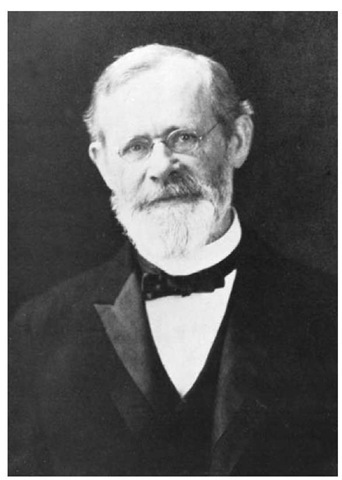Cleveland Abbe ushered in the modern era of meteorology by instituting a national system of daily weather reports and forecasts that served as the prototype for the U.S. Weather Bureau, which he also helped to organize. Abbe helped transform the reporting of weather from a highly localized phenomenon based on conjecture into a coordinated system based on observed facts and informed projections of potential weather developments. Abbe’s "probabilities," as he initially called them, acted as the precursor to the present-day weather forecast.
Abbe was born on December 3, 1838, in New York City, brother of Robert Abbe, the pioneer in plastic surgery who introduced radiation therapy to the United States. Growing up in the city, he became enthralled with weather by reading articles by Merriam, Espy, and Joseph Henry (among others) in the daily newspapers. In the summer of 1857, he read William Ferrel’s classic article on the theories of storms and winds in the Mathematical Monthly, which guided him into the study of meteorology. That year, he graduated from the Free Academy (now the College of the City of New York) and proceeded to conduct graduate studies in astronomy under F. Brunow at Ann Arbor, Michigan, until 1860, and then under B.A. Gould at Cambridge, Massachusetts, until 1864.
Abbe spent the next two years studying and working as an assistant under astronomer Otto Struve at the Observatory of Pulkova in Russia. Upon his return to the United States, he worked briefly at the Naval Observatory before taking up the directorship of the Cincinnati Observatory.
In his inaugural address on May 1, 1868, he outlined his intention of establishing a system of weather reports. John Gano, president of the Cincinnati Chamber of Commerce, pledged his support for such a project, and the Western Union Telegraph Company donated transmissions over its telegraph lines of weather reports from the 40 volunteer meteorological correspondents enlisted by Abbe. The first Cincinnati Weather Bulletin was dispatched on September 1, 1869. In October 1869, Abbe devised a code of cipher for abbreviating the weather reports.
Abbe’s Cincinnati Weather Bulletin served as the prototype for the nationalization of a weather-reporting system, which Smithsonian observer Increase Allen Lapham of Milwaukee urged Congress to establish under the auspices of the Signal Corps of the Army. The U.S. Congress announced a joint resolution supporting the measure on February 2, 1870, and on February 9, President Grant signed the initiative into law, charging the secretary of war with establishing it under the Army Signal Service. Abbe married on May 10, 1870, in the midst of preparations for the institution of the weather report, which went into effect in November 1870.
Cleveland Abbe instituted the first national system of daily weather reports and forecasts.
On January 3, 1871, Abbe was appointed civilian assistant to the chief signal officer, General Albert J. Myer. Together, they organized the Weather Bureau of the Army Signal Service, which oversaw the national weather reports. The reports consisted of thrice daily synopses of current weather conditions, along with "probabilities," or forecasts of possible atmospheric developments. Abbe devised a system to reduce traffic on the electromagnetic telegraph wires by having all of the reporters at the major stations opening up their lines at specific appointed times, each to give their report and then listen to others’ reports, thereby disseminating all the necessary information in a mere 20- to 30-minute interchange. Despite the efficiency of such a system, Western Union refused to dispatch all weather reports on March 4, 1871, forcing the Weather Bureau to use competing telegraph companies for their transmissions.
Abbe continued to impose order on the system he innovated, determining the altitude above sea level of all Signal Service barometers in 1872. The next year, he launched the Monthly Weather Review, a slim bulletin of weather statistics that expanded some 20 years into one of the most respected meteorological journals in the world under Abbe’s editorship. Also in 1873, the International Meteorological Congress established the "Daily Bulletin of Simultaneous International Meteorological Observations," based on Abbe’s national system.
Abbe published prolifically. His most important papers included "Treatise on Meteorological Apparatus and Methods," published in 1887, and "Preparatory Studies for Deductive Methods in Storm and Weather Prediction," published in 1889. Other important titles included Solar Spots and Terrestrial Temperature; A Plea for Terrestrial Physics; Atmospheric Radiation; and Treatise on Meteorological Apparatus.
Abbe was duly recognized for his contributions to science. For example, he was elected to the National Academy of Sciences in 1879. Perhaps the most distinguished honor was his receipt of the Marcellus Hartley medal for Eminence in the Application of Science to the Public Welfare on April 17, 1916. He was unable to attend the ceremony, however, due to ill health. Half a year later, Abbe died at his home in Chevy Chase, Maryland, on October 28, 1916. In his honor, flags in front of the Department of Agriculture and the Weather Bureau in Washington, D.C., were flown at half-mast on the day of his funeral.
Also in his memory, the American Meteorological Society named the Cleveland Abbe Award for Distinguished Service to Atmospheric Sciences by an Individual after him.

